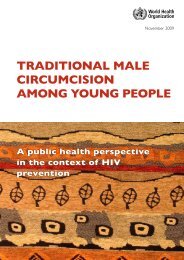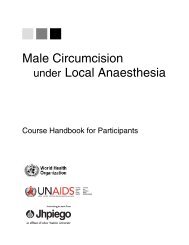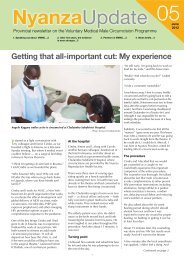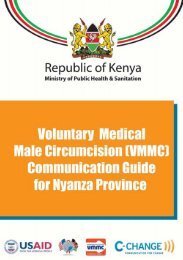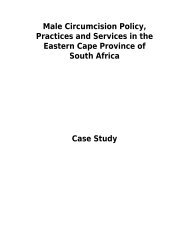Manual for Male Circumcision under Local Anaesthesia
Manual for Male Circumcision under Local Anaesthesia
Manual for Male Circumcision under Local Anaesthesia
You also want an ePaper? Increase the reach of your titles
YUMPU automatically turns print PDFs into web optimized ePapers that Google loves.
<strong>Male</strong> circumcision <strong>under</strong> local anaesthesia Version 2.5C (Jan08)<br />
Chapter 2<br />
Linking male circumcision to other male sexual and reproductive<br />
health services<br />
Summary<br />
• Men have different sexual and reproductive health needs at<br />
different ages.<br />
• <strong>Male</strong> circumcision reduces the risk of acquiring HIV infection by<br />
50–60%, but does not guarantee complete protection. In addition,<br />
it may provide some protection against other sexually transmitted<br />
infections, such as syphilis and herpes, but offers little or no<br />
protection against gonorrhoea and chlamydia.<br />
• <strong>Male</strong> circumcision does not prevent unwanted pregnancy.<br />
Comprehensive education and in<strong>for</strong>mation programmes, and the<br />
provision of services <strong>for</strong> contraception and STI prevention and<br />
management, are needed to address male sexual and<br />
reproductive health needs.<br />
• WHO and UNAIDS recommend HIV testing and counselling <strong>for</strong> all<br />
patients who have signs and symptoms of HIV infection. In certain<br />
epidemic situations, they recommend routinely offering an HIV test<br />
at every contact with health services.<br />
• WHO and UNAIDS recommend that all men who request<br />
circumcision to reduce their risk of HIV infection should be offered<br />
an HIV test.<br />
• The core goals <strong>for</strong> male sexual and reproductive health services<br />
include promoting responsible male sexual behaviour and<br />
encouraging men to support their female partners and children in<br />
meeting their sexual and reproductive health needs.<br />
• Sexual and reproductive health education and services are<br />
important <strong>for</strong> men and adolescents, as well as <strong>for</strong> women. A wide<br />
range of people and organizations can provide in<strong>for</strong>mation and<br />
services, including parents, teachers, nongovernmental<br />
organizations, churches and youth groups, as well as health care<br />
providers in outpatient, family planning, STI, and HIV clinics. Every<br />
opportunity to provide education and services should be taken.<br />
• <strong>Male</strong> circumcision services <strong>for</strong> older boys and young men offer an<br />
opportunity to provide sexual and reproductive health education<br />
and counselling to these key groups.<br />
Linking male circumcision and other male SRH services Chapter 2-1<br />
<strong>Male</strong> circumcision <strong>under</strong> local anaesthesia Version 2.5C (Jan08)<br />
MEN'S SEXUAL AND REPRODUCTIVE HEALTH NEEDS AND SERVICES<br />
For many men, accessing circumcision services may be their first contact<br />
with health services. This contact offers an opportunity to address other<br />
aspects of men’s sexual and reproductive health.<br />
As noted in Chapter 1, male circumcision does not provide full protection<br />
against HIV, but appears to reduce the risk of infection by 50–60%. It<br />
gives little or no protection against STIs that affect the urethra, such as<br />
gonorrhoea and chlamydia. It provides no protection against acquisition of<br />
HIV infection from unsafe injections, from infected blood products, or<br />
through receptive anal intercourse. It also does not prevent pregnancy.<br />
To reduce the risk of STIs, including HIV, and unwanted pregnancy,<br />
comprehensive education and in<strong>for</strong>mation programmes are needed, as<br />
well as services <strong>for</strong> contraception and STI prevention and management. A<br />
possible consequence of promoting male circumcision <strong>for</strong> HIV prevention<br />
is that circumcised men may perceive themselves as immune, and<br />
subsequently increase their exposure to HIV, ignoring other important<br />
strategies to reduce risk. These strategies include delaying the onset of<br />
sexual activity, reducing the number of sexual partners, and using<br />
condoms correctly and consistently every time they have sex.<br />
In many societies where male circumcision is per<strong>for</strong>med at the beginning<br />
of adolescence, as a rite of passage to adulthood, the circumcision<br />
festival period is used also to educate young men about various health<br />
and social issues. These cultural traditions can be harmonized with<br />
modern clinical practice, to ensure the safety of circumcision, and to use<br />
the opportunity to educate the young men about a number of sexual and<br />
reproductive health issues.<br />
<strong>Male</strong> circumcision should there<strong>for</strong>e be regarded as an entry point <strong>for</strong><br />
sexual, reproductive and other health services <strong>for</strong> men (Fig. 2.1),<br />
including:<br />
• sexual and reproductive health education and counselling;<br />
• screening and treatment <strong>for</strong> sexually transmitted infections;<br />
• counselling and testing <strong>for</strong> HIV (with referral <strong>for</strong> care and support<br />
<strong>for</strong> those testing positive);<br />
• family planning education, counselling and services, including<br />
provision of condoms and vasectomy;<br />
• evaluation and treatment <strong>for</strong> infertility;<br />
• counselling on gender issues, including promotion of respect <strong>for</strong><br />
women’s and girls' sexual and reproductive health needs and<br />
rights and the importance of preventing gender-based violence;<br />
• education about cancers of the male reproductive organs (testes,<br />
penis and prostate);<br />
• counselling <strong>for</strong> alcohol dependence and other substance abuse,<br />
which are associated with a number of health risks.<br />
Linking male circumcision and other male SRH services Chapter 2-2





